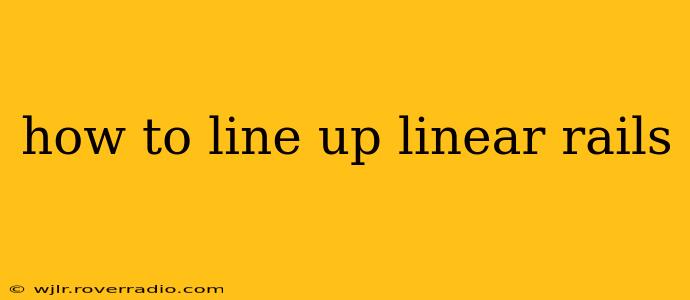Linear rails, also known as linear guides or linear bearings, are crucial components in many applications requiring precise, smooth linear motion. Proper alignment is critical for optimal performance, extended lifespan, and preventing premature wear. This guide will walk you through the process, addressing common questions and concerns.
What Tools Do I Need to Line Up Linear Rails?
Before you begin, gather the necessary tools. This typically includes:
- Measuring tools: Precision level, dial indicator, straightedge, calipers, and a measuring tape. The accuracy of your tools directly impacts the accuracy of your alignment.
- Shims: These are thin pieces of metal used to adjust the height and alignment of the rails. Various thicknesses are beneficial for fine-tuning.
- Clamps and fasteners: Appropriate clamps to secure the rails during alignment and fasteners to mount them securely.
- Torque wrench: This ensures consistent tightening of fasteners, preventing over-tightening and damage.
- Cleaning supplies: Isopropyl alcohol and lint-free cloths to clean the rails and mounting surfaces before installation.
How Do I Check the Straightness of My Linear Rails Before Installation?
Before even attempting alignment, verify the straightness of your linear rails. Use a precision straightedge or a dial indicator to check for any bends or warps. Even slight imperfections can lead to significant alignment problems later on. Replace any damaged or warped rails. This initial step saves time and potential frustration down the line.
How Do I Ensure Parallel Alignment of Linear Rails?
Parallel alignment is crucial for smooth, consistent movement. This typically involves using a precision level and shims.
-
Mount one rail: Securely mount one rail to its intended location. Ensure it’s level and plumb using a precision level.
-
Align the second rail: Position the second rail parallel to the first. Use a precision level and straightedge to check for parallelism.
-
Shim as needed: Use shims to adjust the height of the second rail until it's perfectly parallel to the first. Check frequently with your level and straightedge.
-
Secure the second rail: Once parallel alignment is achieved, securely fasten the second rail to its mounting surface. Use a torque wrench to ensure consistent tightening of fasteners.
How Much Play Should Be Between Linear Rails and the Carriage?
The amount of play (clearance) between the linear rails and the carriage depends on the specific application and manufacturer's recommendations. Too much play results in unstable movement and increased wear. Too little play can cause binding and increased friction. Consult the manufacturer's specifications for the optimal clearance.
What If My Linear Rails Are Not Parallel?
If the rails are not parallel after installation, you might need to revisit the mounting process. Double-check your mounting surfaces for imperfections. In some cases, it may be necessary to slightly adjust the mounting surface to achieve proper parallelism.
What Causes Linear Rail Misalignment?
Several factors can cause linear rail misalignment:
- Improper mounting surface preparation: Uneven or damaged mounting surfaces are a common cause of misalignment.
- Loose or incorrectly tightened fasteners: Insufficient tightening or over-tightening can lead to misalignment.
- Warped or damaged rails: Using damaged rails will inevitably result in misalignment.
- Improper shimming: Incorrectly used or insufficient shims will cause misalignment.
How Often Should I Check Linear Rail Alignment?
Regular inspection is crucial for maintaining optimal performance. The frequency depends on the application's usage and environment. However, periodic checks (e.g., monthly or quarterly) are recommended to ensure continued smooth operation and prevent premature wear.
By following these steps and paying attention to detail, you can ensure the accurate alignment of your linear rails, leading to smoother operation, longer lifespan, and improved overall performance of your system. Remember to always consult the manufacturer's instructions for your specific linear rail system.
